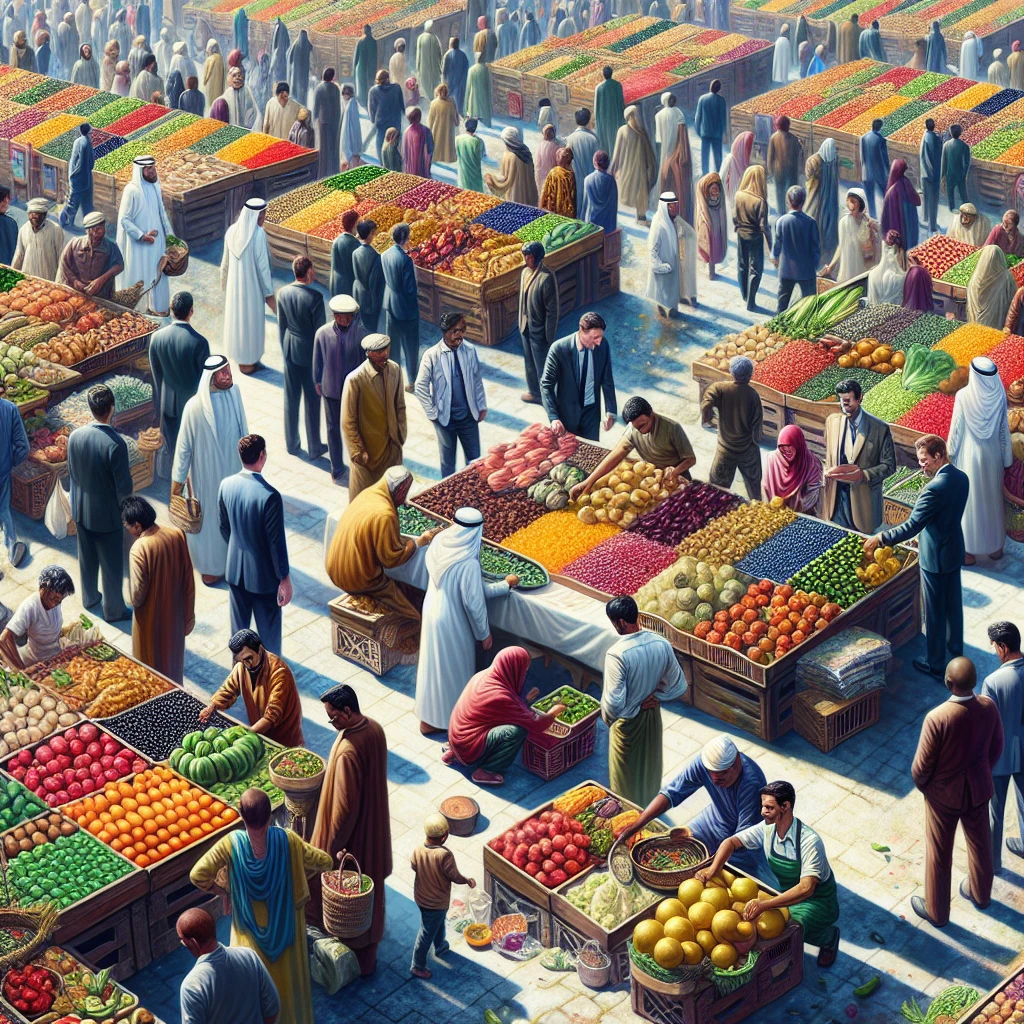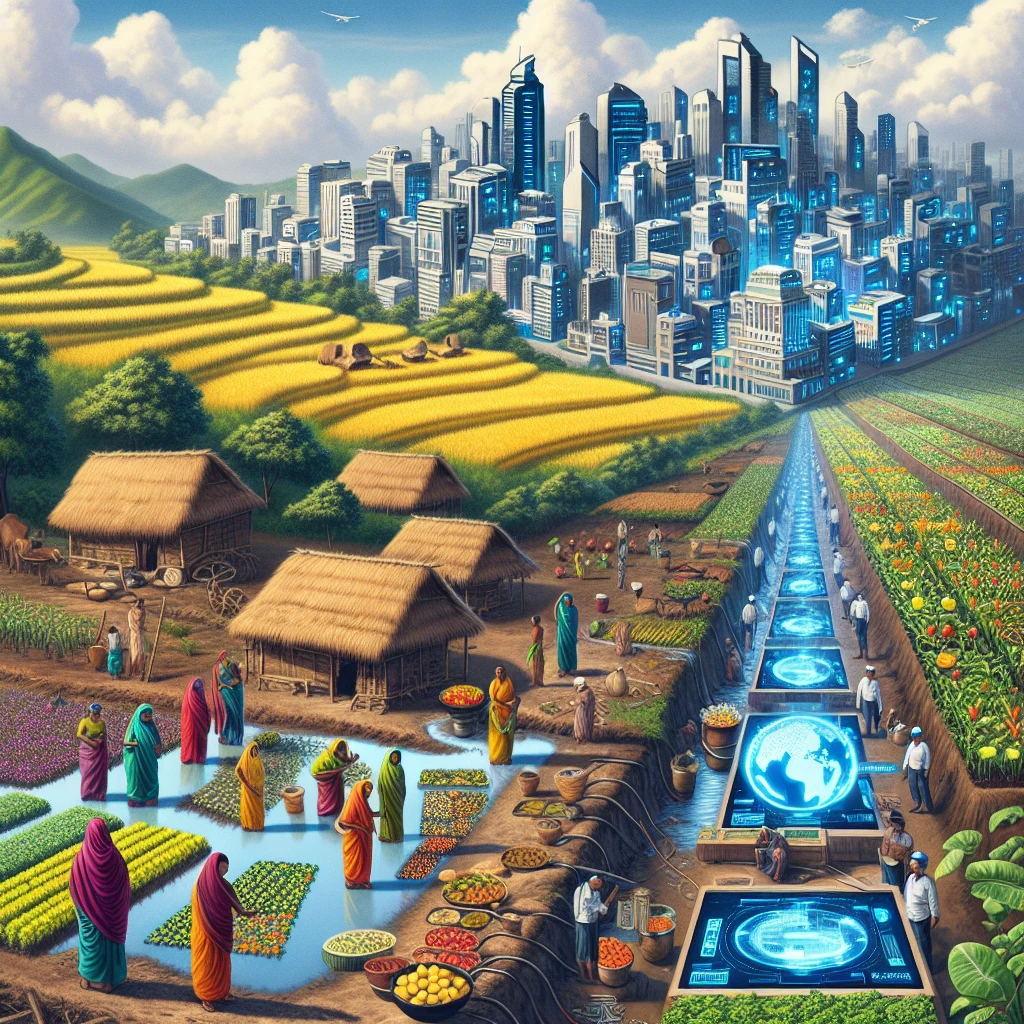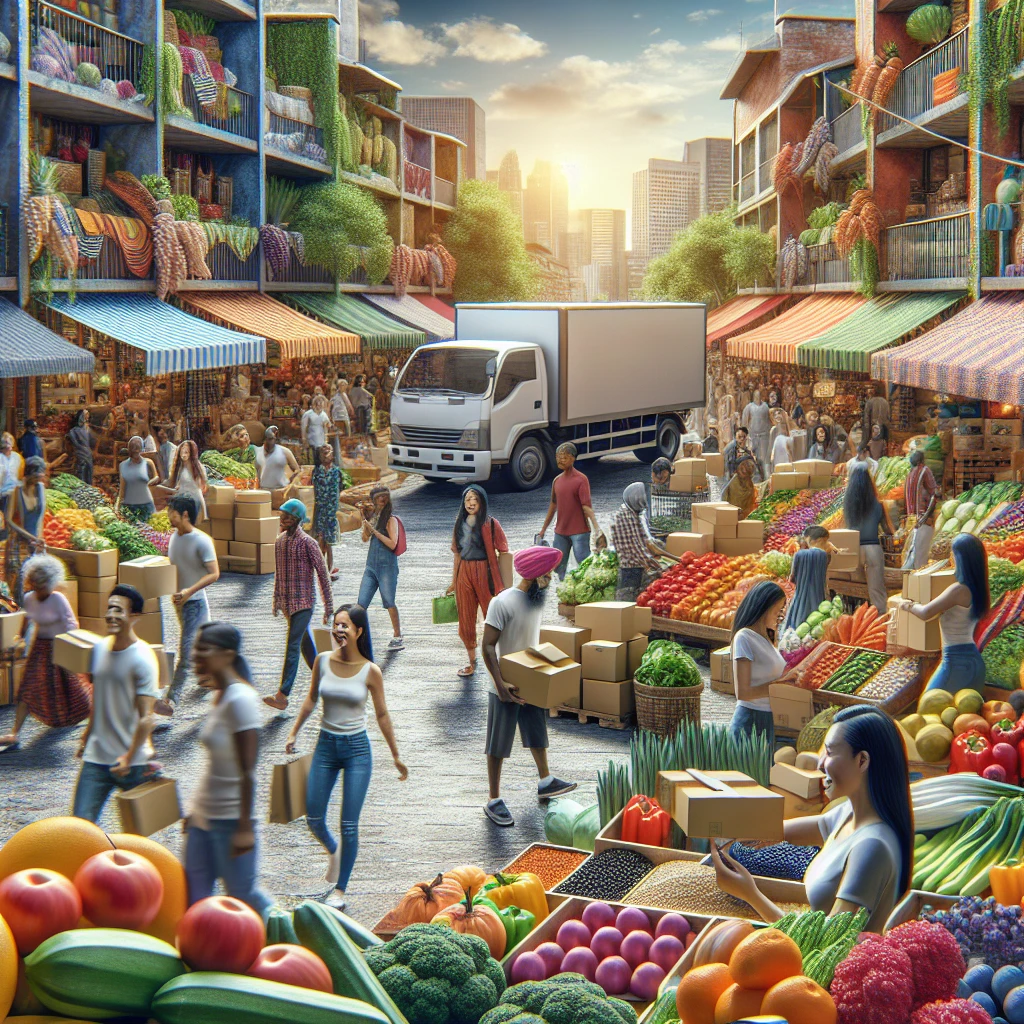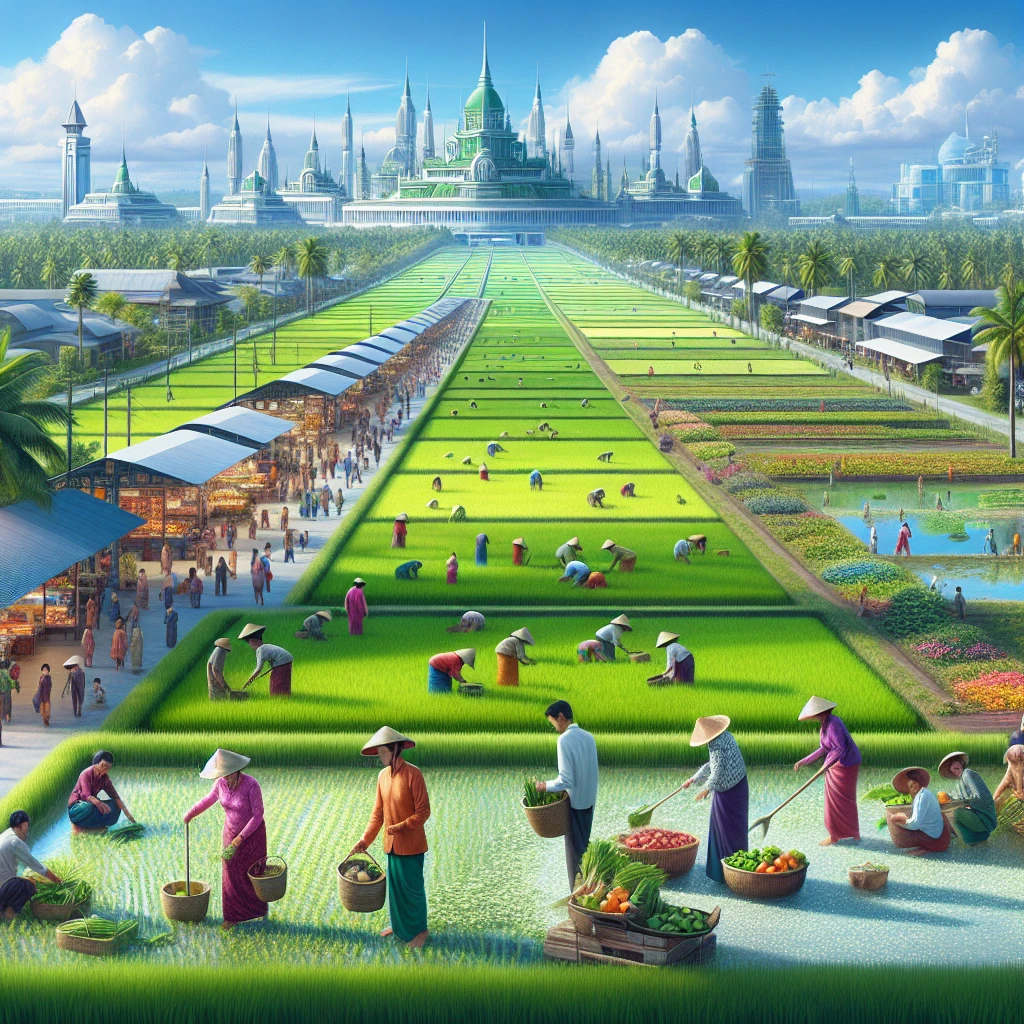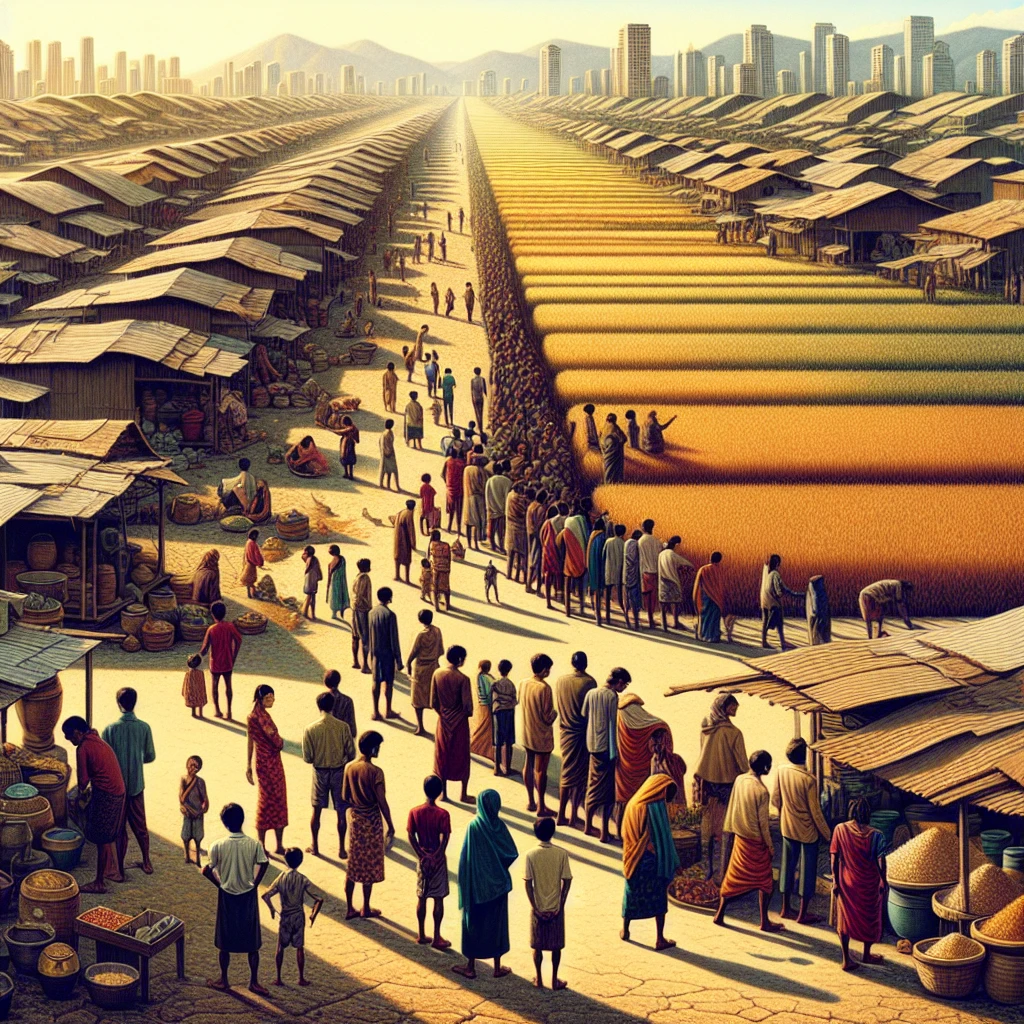

Food shortages in South and Southeast Asia have become a critical concern due to slowing gains in agricultural productivity, overexploitation of natural resources, and increasing water scarcity. Understanding the causes of food shortages in the region is important in order to address the issues and work towards long-term solutions for food security.
The lack of available food supplies, poverty, and disruptions to food supplies beyond the COVID-19 pandemic are some of the contributing factors to the food crisis in South and Southeast Asia.
Economic Factors
The impact of economic instability on food production and availability is profound, with disruptions in global supply chains causing shortages and price hikes. For instance, trade barriers and labor shortages have hindered the transportation and production of essential food items, leading to scarcity in the market.
This instability also affects the investment in agricultural infrastructure, leading to decreased productivity and availability of food.
Furthermore, poverty significantly influences access to food and agricultural resources in South and Southeast Asia. Impoverished communities often lack the financial means to purchase nutritious food, leading to malnutrition and food insecurity.
Additionally, limited access to agricultural resources such as land and modern farming equipment perpetuates the cycle of poverty and food shortages in the region.
In essence, economic instability and poverty intertwine to create a complex web of challenges that hinder food production and accessibility in South and Southeast Asia.
| Factors | Impact |
|---|---|
| Economic Instability | Disruptions in supply chains and reduced agricultural investment |
| Poverty | Limits access to nutritious food and agricultural resources |
These factors necessitate a holistic approach to address the root causes of food shortages in the region, encompassing economic reforms, poverty alleviation programs, and investment in sustainable agriculture.
Climate Change
The effects of climate change on agriculture and food production are significant. With increasing temperatures and carbon dioxide levels, some crop yields may increase.
However, heavy rainfall can lead to soil erosion, posing a major threat to sustainable crop production. Additionally, droughts and extreme weather events can harm crops and reduce overall yields, impacting food production in South and Southeast Asia.
Droughts, floods, and extreme weather events exacerbate food shortages in South and Southeast Asia. These events disrupt food availability, reduce access to food, and can severely affect food quality.
The higher average global temperatures and more extreme weather events associated with climate change will reduce the reliability of food production in the region, leading to widespread food shortages.
Here’s a table illustrating the impact of climate change on agriculture and food production:
| Climate Change Effects | Impact on Food Production |
|---|---|
| Increased temperatures and CO2 levels | Some crop yields may increase |
| Heavy rainfall | Increases soil erosion, posing a threat to crop production |
| Droughts and extreme weather events | Harm crops and reduce overall yields |
Climate change significantly affects agriculture and food production, leading to severe consequences such as food shortages due to the impact of extreme weather events in South and Southeast Asia.
Government Policies
Examination of government policies and their impact on food security
Government policies play a crucial role in shaping the food security landscape. By implementing programs like SNAP and NSLP, the government aids families experiencing food insecurity.
These policies directly impact the ability of individuals to access nutritious meals, particularly in regions facing shortages. The U. S. Government’s Global Food Security Strategy strives to end global hunger, poverty, and malnutrition through collaborative initiatives like the Feed the Future program, reflecting the profound impact of such policies on food security.
Role of trade barriers and subsidies in exacerbating food shortages
Trade barriers and subsidies wield significant influence over exacerbating food shortages. Many governments aim to boost domestic agricultural incomes by setting high prices while erecting trade barriers, inadvertently constraining access to crucial food supplies.
Additionally, subsidies can create distortions in international commerce and contribute to volatile world prices, thus intensifying food scarcity. The implications of these economic interventions underscore their pivotal role in aggravating food shortages in South and Southeast Asia.
Land Degradation
The consequences of land degradation on agricultural productivity are severe. It decreases land productivity, biodiversity, and ecosystem services, leading to a heightened risk of economic loss in various sectors, including agriculture and ecotourism.
This contributes to poverty, food insecurity, susceptibility to extreme weather events, and even conflict, as illustrated in the movie “Avatar.” Overuse of land and soil erosion are significant factors leading to decreased food production. Wind and water erosion account for 79% of total degraded land, with acidic and alkaline soils contributing to the problem.
These issues have a direct impact on agricultural productivity, leading to lower crop harvests and reduced farmer revenues, ultimately exacerbating food shortages in South and Southeast Asia.
| Consequences of Land Degradation | Overuse of Land and Soil Erosion |
|---|---|
| – Decreased land productivity | – Primary causes of land degradation |
| – Reduced biodiversity and ecosystem services | – Account for 79% of total degraded land |
| – Heightened risk of economic loss and food insecurity | – Impact on agricultural productivity and food production |
Population Growth
The impact of population growth on food demand and supply is significant, as the rising number of people directly correlates with an increased need for food. This surge in demand places immense pressure on the existing food supply chain, requiring an almost doubling of food production in developing countries by 2050 to meet the escalating needs.
As a result, the strain on resources due to the swelling population in South and Southeast Asia is evident, causing challenges such as land pressure, habitat destruction, water scarcity, air pollution, and climate change. The rapid increase in population also impacts economic growth, exacerbating foreign trade imbalances and leading to an unequal distribution of resources.
| Challenges Due to Population Growth | |
|---|---|
| Land pressure | Habitat destruction |
| Water scarcity | Air pollution |
| Climate change | Economic imbalances |
Food Waste
Analysis of food waste and its contribution to food shortages
Food waste significantly contributes to food shortages in South and Southeast Asia. The inefficient distribution and management of food resources, coupled with poor infrastructure and storage facilities, lead to a substantial amount of food being wasted.
This wastage directly impacts the availability of food for the population, exacerbating the issue of food shortages in these regions.
Strategies to reduce food waste and improve food security
Implementing effective strategies to reduce food waste is crucial in improving food security. These strategies include adopting sustainable agricultural practices, enhancing transportation and storage infrastructure, and educating the population on proper food management.
By employing these measures, the amount of food wasted can be significantly reduced, consequently contributing to improved food security in South and Southeast Asia.
| Strategies to Reduce Food Waste |
|---|
| 1. Enhance storage facilities |
| 2. Educate on food management |
| 3. Implement sustainable practices |
The analysis of food waste and the subsequent implementation of strategies to mitigate it are vital steps towards addressing the issue of food shortages in South and Southeast Asia.
Infrastructure Challenges
The impact of inadequate infrastructure on food distribution in South and Southeast Asia is profound. With poor road infrastructure and limited transportation options, the efficient transfer of food from production centers to consumption areas becomes a major challenge.
This results in delayed deliveries, increased spoilage, and ultimately contributes to food shortages in these regions.
The lack of storage facilities further exacerbates the issue, as perishable food items are unable to be adequately preserved for extended periods. This leads to significant food loss and wastage, impacting overall food availability and accessibility.
In addition, the absence of refrigerated warehouse infrastructure makes it difficult to store temperature-sensitive goods, especially in hot and humid climates, further contributing to the scarcity of food.
Furthermore, the inadequate transportation infrastructure directly affects the timely and reliable distribution of food products. Poor road conditions and insufficient transportation networks hinder the swift movement of goods from farms to markets, resulting in logistical challenges and prolonged delivery times.
This, in turn, significantly contributes to food shortages in the South and Southeast Asian regions.
Additionally, studies have shown that the unavailability of efficient transportation directly correlates with food insecurity. Without proper access to transportation, especially for small-scale farmers, the efficient movement of produce to marketplaces is severely compromised.
This ultimately impacts the overall food supply chain, leading to significant shortages in the availability of food for the population. Such infrastructure challenges have far-reaching implications for food security in the region.
The inadequate infrastructure, encompassing both storage facilities and transportation networks, plays a pivotal role in the emergence of food shortages in South and Southeast Asia. Addressing these infrastructure challenges is crucial to ensuring a more robust and sustainable food distribution system, thereby safeguarding the accessibility and availability of essential food supplies for the population.
Conflict and Instability
The effects of political conflict and instability on food security are profound, as these situations disrupt the production, distribution, and access to food. In regions experiencing political turmoil, agricultural activities are often disrupted, leading to decreased food production and availability.
Additionally, the breakdown of governance structures and infrastructure hinders the distribution of food to those in need, exacerbating food shortages.
Furthermore, food shortages as a result of war, displacement, and violence are a direct consequence of conflict and instability. In these contexts, warring parties may deliberately destroy agricultural assets, such as farms and livestock, leading to severe food shortages for civilian populations.
Additionally, displacement due to conflict severs individuals from their food supplies and livelihoods, further contributing to food insecurity.
| Example |
|---|
| The civil war in Country X led to the destruction of farmlands and displacement of farmers, resulting in widespread food shortages. |
Political conflict and instability have far-reaching effects on food security, leading to shortages and scarcity, especially in South and Southeast Asia. These challenges necessitate effective governance, conflict resolution, and humanitarian interventions to address the root causes and alleviate the suffering of affected populations.
Water Scarcity
Water scarcity has dire consequences on agricultural output, leading to significant declines in crop and livestock productivity. The lack of water for irrigation and livestock watering results in reduced food production, impacting the availability of food for the increasing population.
According to the International Water Management Institute, agriculture, which accounts for about 70% of global water withdrawals, faces constant competition with domestic water needs.
Consequences of water scarcity on agricultural output
The consequences of water scarcity on agricultural output are severe. With inadequate water supply for irrigation, crop yields decrease, affecting food availability and leading to increased costs to access water for agricultural purposes.
Livestock productivity also suffers, disrupting the supply of meat and dairy products.
Measures to address water scarcity and improve food production
To address water scarcity and enhance food production, several techniques in water management for rainfed agriculture can be employed. These include implementing supplemental irrigation and water harvesting methods such as rain catchment systems and sand dams to ensure consistent water supply.
Furthermore, investing in more water-efficient crop varieties, promoting improved agronomic practices, and incentivizing farmers to conserve upper watersheds can significantly contribute to alleviating water scarcity and enhancing food security.
| Consequences of Water Scarcity | Measures to Address Water Scarcity and Improve Food Production |
|---|---|
| Decreased crop and livestock productivity | Implementation of supplemental irrigation and water harvesting techniques |
| Increased costs for accessing water for agricultural purposes | Adoption of more water-efficient crop varieties and improved agronomic practices |
Addressing water scarcity is essential to ensure sustainable food production and meet the growing demand for agricultural products. By implementing effective water management strategies and promoting water-efficient practices, it is possible to mitigate the impact of water scarcity and enhance food security.
Your actual response should be written all in this language: English (USA)
Agricultural Practices
Examination of unsustainable agricultural practices
The degradation of land, soil, and nutrients due to unsustainable farming techniques is a significant contributor to food shortages in South and Southeast Asia. Modern agriculture often relies on synthetic manures, pesticides, and poor farming practices, leading to soil degradation and reduced fertility.
Additionally, the emphasis on quantity over quality drives farmers to produce monocrops, degrading the land and exacerbating food insecurity.
Adoption of sustainable farming techniques to mitigate food shortages
To address these challenges, the adoption of sustainable agriculture practices such as organic farming, agroecology, and permaculture is crucial. These techniques promote soil fertility, reduce chemical inputs, and minimize water consumption, leading to more sustainable and resilient agricultural systems.
By valuing quality over quantity and implementing soil conservation methods, farmers can help mitigate food shortages and contribute to long-term food security in the region.
Access to Technology
Influence of access to technology on agricultural productivity
Access to technology has revolutionized agricultural productivity in South and Southeast Asia. The use of advanced sensors, drones, and GPS technology has enabled farmers to monitor and manage their crops with precision, leading to increased yields and reduced resource waste.
For example, the implementation of smart agriculture technology has significantly improved crop monitoring, pest control, and irrigation management, resulting in higher productivity and sustainable farming practices.
Use of innovative solutions to improve food production and access
Innovative solutions, such as blockchain technology, have played a crucial role in improving food production and access in the region. Blockchain ensures food traceability, reducing food fraud, safety recalls, and supply chain inefficiencies.
Additionally, the digital economy has optimized the allocation and circulation of agricultural production elements, enhancing overall efficiency and productivity. These innovative technological approaches have paved the way for a more connected, sustainable, and resilient food production system in South and Southeast Asia.
Global Market Dynamics
Impact of global market dynamics on food availability in South and Southeast Asia
The global market dynamics have greatly impacted food availability in South and Southeast Asia. Disruptions in global supply chains, trade restrictions, and movement restrictions have led to challenges in sourcing and distributing food across the region.
This has resulted in reduced food availability and affordability, especially for vulnerable populations in these areas. Additionally, the lingering effects of Covid-19 supply chain disruptions continue to plague the global food system, further exacerbating the food availability challenges in South and Southeast Asia.
Role of international trade agreements and economic forces
International trade agreements and economic forces play a crucial role in shaping food availability in South and Southeast Asia. They directly impact the flow of food products and resources within the region.
The recent rise in global food prices has been influenced by international trade agreements, leading to fluctuations in food availability and affordability in South and Southeast Asia. Furthermore, the disruptions in supply chains have prompted multinational companies to reassess their approach to global manufacturing and sourcing, impacting the availability of food in the region.
| Impacts | Examples |
|---|---|
| Increased food scarcity | Reduced availability of essential food items |
| Fluctuating food prices | Economic instability affecting food affordability |
The global market dynamics and international trade agreements have significantly affected the food availability and affordability in South and Southeast Asia, posing challenges for the region’s food security.
Health and Nutrition
Consequences of food shortages on public health and nutrition
Food shortages in South and Southeast Asia have severe consequences on public health and nutrition. When people lack access to affordable and nutritious food, it leads to malnutrition and increases the risk of chronic health conditions.
Studies have found a direct correlation between food insecurity and health disorders such as obesity, heart disease, high blood pressure, diabetes, and various cancers. This means that inadequate food supplies directly impact the overall well-being of the population, posing long-term health risks.
Strategies to improve nutritional outcomes during food shortages
To combat the detrimental effects of food shortages on public health and nutrition, several strategies can be implemented. Firstly, reducing food waste and loss can significantly improve food security.
Additionally, programs like the Supplemental Nutrition Assistance Program (SNAP) have been linked with improved nutritional outcomes and reduced food insecurity. Another effective strategy is the promotion of food service and nutrition guidelines, ensuring that healthy food procurement systems are implemented, especially in facilities serving vulnerable populations.
Moreover, a combination of food production, diversification, sanitation interventions, and nutrition education is crucial in achieving improved nutritional well-being during food shortages.
| Strategy | Description |
|---|---|
| Reduce Food Waste and Loss | By minimizing food waste and loss, more food can be made available for those experiencing shortages. |
| SNAP Program | The Supplemental Nutrition Assistance Program has shown to improve nutritional outcomes and decrease food insecurity, especially among vulnerable groups. |
| Promotion of Nutrition Guidelines | Implementing healthy food procurement systems in facilities and programs can ensure access to nutritious meals, particularly for at-risk populations. |
| Comprehensive Approach | Combining food production, diversification, sanitation interventions, and nutrition education is essential for enhancing nutritional well-being during food shortages. |
By implementing these strategies, it’s possible to mitigate the negative impact of food shortages on public health and nutrition, ultimately improving the overall well-being of the population in South and Southeast Asia.
Community and Local Solutions
Role of local communities in addressing food shortages
Local communities play a vital role in addressing food shortages in South and Southeast Asia. By organizing community food drives and establishing community gardens, they can directly contribute to increasing food availability.
Through these initiatives, local communities can provide immediate relief to those experiencing food insecurity while also fostering a sense of togetherness and support within the community.
Implementation of community-based solutions for food security
In the implementation of community-based solutions for food security, it is crucial for local communities to collaborate with food banks, food pantries, and local government agencies. By establishing food distribution programs and promoting sustainable agricultural practices, communities can work towards long-term solutions for food security.
Additionally, exploring initiatives such as urban farming and community-supported agriculture can further ensure access to fresh and nutritious food options within the local area.
Education and Awareness
Importance of education and awareness in addressing food shortages
Knowledge and awareness play a pivotal role in addressing food shortages in South and Southeast Asia. Through education, individuals and communities can gain a deeper understanding of sustainable agricultural practices, efficient food distribution systems, and the impact of climate change on food production.
This awareness empowers them to make informed decisions and take proactive measures to mitigate food shortages.
Empowerment through knowledge and information about food security
Empowering individuals with knowledge about food security enables them to identify and implement sustainable solutions. By understanding the causes of food shortages, communities can develop localized strategies to enhance crop yields, diversify food sources, and promote responsible consumption.
Access to information on food security also fosters partnerships and collaboration, leading to the development of innovative initiatives to ensure a steady and reliable food supply for the region.
Policy Recommendations
Proposed policy measures to mitigate food shortages in South and Southeast Asia
In order to mitigate food shortages in South and Southeast Asia, it is imperative to implement comprehensive policy measures that address the root causes of the crisis. This includes investing in sustainable agricultural practices, infrastructure development, and technological advancements to enhance crop yields and promote food security.
Additionally, there should be a focus on promoting farmer education and providing financial incentives to encourage sustainable farming practices, which can contribute to long-term food security in the region.
Furthermore, it is crucial to establish effective trade agreements and partnerships among nations in South and Southeast Asia to ensure smooth and efficient food supply chains. This can help in mitigating food shortages by allowing for the equitable distribution of food resources and reducing dependency on imports from other regions.
Strengthening regional cooperation and coordination in addressing food shortages is essential for implementing effective and sustainable policy measures.
One concrete example of a proposed policy measure is the establishment of regional organizations or initiatives aimed at promoting agricultural innovation, food waste reduction, and climate-resilient farming techniques. These efforts can play a vital role in addressing food shortages and promoting sustainable food systems in the region.
| Proposed Policy Measures to Mitigate Food Shortages |
|---|
| 1. Invest in sustainable agricultural practices |
| 2. Strengthen regional cooperation for food supply |
| 3. Promote farmer education and incentives |
Advocacy for sustainable and equitable food systems
Advocating for sustainable and equitable food systems in South and Southeast Asia requires a multi-faceted approach that encompasses various stakeholders. It is essential to prioritize the support and empowerment of smallholder farmers, who play a pivotal role in food production and contribute significantly to regional food security.
Additionally, there is a need for advocacy efforts aimed at promoting climate-smart agricultural practices and increasing access to modern agricultural technologies and resources. By advocating for the integration of sustainable farming methods and equitable distribution of resources, stakeholders can contribute to the development of resilient and inclusive food systems in the region.
Moreover, collaboration with international organizations and development agencies can amplify advocacy efforts, leading to the implementation of impactful policies and initiatives that prioritize sustainability and equity in the food supply chain of South and Southeast Asia.
Advocating for sustainable and equitable food systems necessitates the collective action of governments, non-governmental organizations, and relevant stakeholders to drive positive change and address the multifaceted challenges of food shortages in South and Southeast Asia.
Recommended Amazon Products for Food Security in South and Southeast Asia
Here’s a curated list of products that can help address food shortages in South and Southeast Asia. These recommendations are based on their functionality, price, and customer reviews.
Water Purification Tablets


Water purification tablets are essential for areas facing water scarcity as they can make contaminated water safe to drink. The potable aqua water purification tablets are highly recommended for their effectiveness and ease of use.
Solar-Powered Lantern


In regions where access to electricity is limited, solar-powered lanterns can aid in food production and distribution at night. The MPOWERD Luci Outdoor 2.0 is a top recommendation due to its durability and long battery life.
Drought-Resistant Seeds


Given the impact of climate change on agriculture, drought-resistant seeds can help maintain food production in challenging environments. The Survival Garden 15,000 Non GMO Heirloom Vegetable Seeds pack is highly rated for its variety and quality.
Portable Solar Cooker


In areas with inadequate infrastructure, portable solar cookers can provide an alternative cooking solution, reducing the demand for firewood. The GoSun Go Portable Solar Cooker is a top choice for its portability and efficiency.
Community-Based Farming Tools


Empowering local communities through appropriate farming tools can enhance agricultural productivity. The Fiskars 3 Piece Tree and Shrub Care Kit is recommended for its quality and suitability for community-based farming.
Top Recommended Product for Food Security in South and Southeast Asia
If you’re looking for the best solution to address food shortages in South and Southeast Asia, we highly recommend the potable aqua water purification tablets. These tablets are effective in purifying water, an essential resource for food security.
| Product | Pros | Cons |
|---|---|---|
| Water Purification Tablets | – Effective purification- Easy to use- Portable | – May have a slight taste- Limited quantity per pack |
| Solar-Powered Lantern | – Long battery life- Durable- Eco-friendly | – Initial cost may be high- Dependent on sunlight availability |
| Drought-Resistant Seeds | – Non-GMO and heirloom- Variety of seeds- High quality | – Requires proper storage- Need for knowledge on planting methods |
| Portable Solar Cooker | – Environmentally friendly- Portability- No fuel requirements | – Limited capacity for large quantities- Dependence on sunlight |
| Community-Based Farming Tools | – Quality and durability- Suitable for community use- Versatility | – May require training for proper use- Initial investment for acquisition |
Conclusion
The main causes of food shortages in South and Southeast Asia include rapid population growth, inadequate infrastructure, and climate change. The increasing demand for food due to population growth has put a strain on the limited resources and distribution systems in the region.
Additionally, the lack of proper infrastructure for transportation and storage further exacerbates the food shortage problem, leading to significant food wastage.
Furthermore, in order to address food insecurity in South and Southeast Asia, it is imperative that immediate action is taken. This could include investment in agricultural technology and infrastructure, as well as the implementation of sustainable farming practices to increase food production and distribution.
Additionally, there needs to be a focus on addressing the effects of climate change and promoting policies that support food security in the region. It is crucial for governments, organizations, and individuals to work together to ensure that everyone has access to an adequate and nutritious food supply.
Addressing food shortages in South and Southeast Asia requires a collaborative effort from all sectors of society. It is important for governments to prioritize policies and investments that support food security, as well as for individuals to advocate for sustainable food practices.
By working together, we can make significant strides in addressing food insecurity and ensuring that everyone has access to enough nutritious food in the region.


